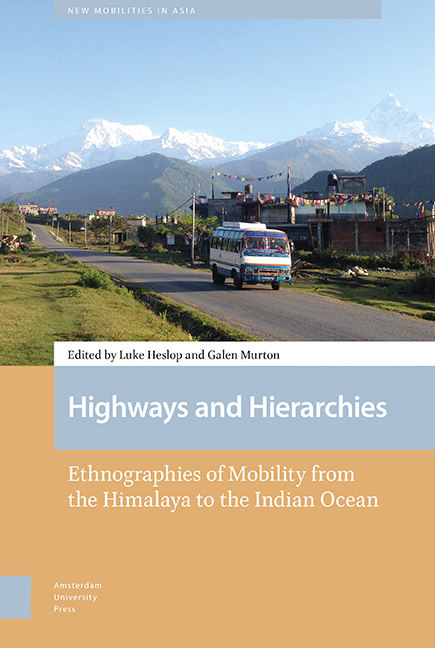Book contents
- Frontmatter
- Contents
- List of figures
- Acknowledgements
- Preface: Thinking with roads
- 1 Why highways remake hierarchies
- 2 Stuck on the side of the road: Mobility, marginality, and neoliberal governmentality in Nepal
- 3 A road to the ‘hidden place’: Road building and state formation in Medog, Tibet
- 4 Dhabas, highways, and exclusion
- 5 The edge of Kaladan: A ‘spectacular’ road through ‘nowhere’ on the India-Myanmar borderlands
- 6 The making of a ‘new Dubai’: Infrastructural rhetoric and development in Pakistan
- 7 Encountering Chinese development in the Maldives: Gifts, hospitality, and rumours
- 8 Roads and the politics of thought: Climate in India, democracy in Nepal
- Authors notes
- Index
3 - A road to the ‘hidden place’: Road building and state formation in Medog, Tibet
Published online by Cambridge University Press: 13 November 2021
- Frontmatter
- Contents
- List of figures
- Acknowledgements
- Preface: Thinking with roads
- 1 Why highways remake hierarchies
- 2 Stuck on the side of the road: Mobility, marginality, and neoliberal governmentality in Nepal
- 3 A road to the ‘hidden place’: Road building and state formation in Medog, Tibet
- 4 Dhabas, highways, and exclusion
- 5 The edge of Kaladan: A ‘spectacular’ road through ‘nowhere’ on the India-Myanmar borderlands
- 6 The making of a ‘new Dubai’: Infrastructural rhetoric and development in Pakistan
- 7 Encountering Chinese development in the Maldives: Gifts, hospitality, and rumours
- 8 Roads and the politics of thought: Climate in India, democracy in Nepal
- Authors notes
- Index
Summary
Abstract
Medog County, located in the southeast of Tibet, was the last county inaccessible by road in China and was widely described as ‘a lotus in the hidden place’. The Medog Highway, linking Medog with the rest of the country, was constructed first in 1994 and, following years of landslides and natural disasters, completed for the second time in 2013. Utilizing ethnographic insights into the usage and non-usage of the Medog Highway, this chapter reveals how the road was constructed and used in specific political, social and cultural contexts. In terms of state formation, the road was not only used as a material infrastructure to integrate the Medog people and a strategic investment of international politics, but also as a discursive symbol to enhance the state's legitimacy to the whole nation. This chapter argues that, besides connection and integration, two other techniques – channelling and filtering – are also constitutive of state formation via road construction. With this road, goods and ideas connected to broader processes of globalization were also channelled into the area, producing both asymmetric connectivity and one-way integration. Furthermore, control and surveillance have also increased after the completion of the road, resulting in both proactive and reactive state efforts to evict unwelcome activities. Producing not only connectivity but also new disconnectivity and social exclusion, I therefore describe the Medog Highway as ‘a punctuated road’.
Keywords: Tibet, China, state formation, connectivity, integration
Introduction
Medog County was the last county inaccessible by road in China. The completion of the Medog Highway ends Medog County's history of inaccessibility. With the concerns of the central government, a motorway began to be built in 1975, however, the construction project was suspended until 1988. With the approval in 1988 and 1990, the road was extended and is completed today. The road has great political and economic significance. The starting point of the Medog Highway is Zhamu Township in Bomi County, and the 142-kilometre-long route ends in the county seat of Medog County. This road climbs over the Galongla Snow Mountain, and crosses the geologically complex regions of the Galongla Zangbu River Valley and the Jinzhu Zangbu River Valley.
- Type
- Chapter
- Information
- Highways and HierarchiesEthnographies of Mobility from the Himalaya to the Indian Ocean, pp. 69 - 96Publisher: Amsterdam University PressPrint publication year: 2021



